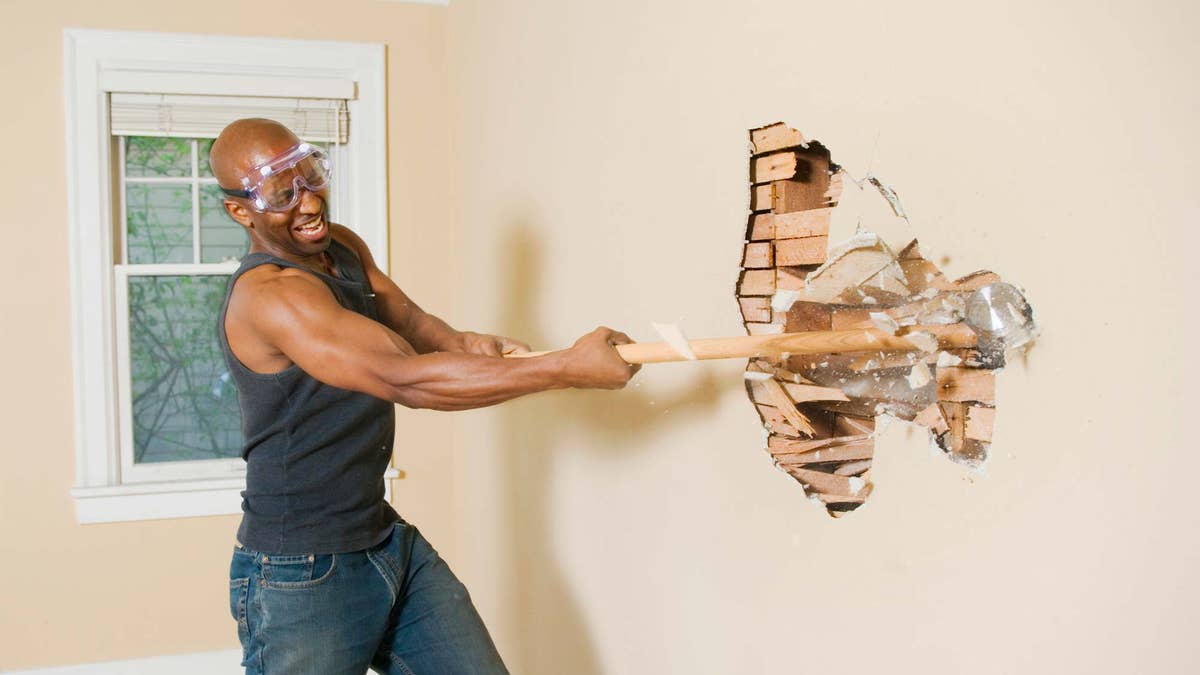
demolishing wall with sledgehammer (This content is subject to copyright.)
With open floor plans all the rage these days, you may be thinking seriously of tearing down a wall or two in your home. So, how do you do it without destroying your place or, at the very least, creating on ungodly mess?
For starters, it's not as simple as swinging a sledgehammer. Follow these steps on how to knock down a wall with minimal danger and damage.
1. Determine whether a wall is load-bearing
This is critical: One wall you definitely won't want to mess with is a load-bearing one. This is a wall that helps carry the weight of your house, so if you knock it down, you could do serious damage to the structural integrity of your home.
So how do you tell if it's a load-bearing wall? First, exterior walls are always load bearing. As for interior walls, the best way to check them is to look at your home's blueprints. One reliable sign an interior wall is load-bearing is if it extends for more than one story all the way up to the roof.
If you're still uncertain, call in a contractor to be absolutely sure and hire a professional to take care of the demolition.
Even if a wall is not load-bearing, another question you'll want to answer before you start swinging is whether it contains pipes or electrical wires. If so, this is yet another time to consider hiring a pro. If wiring and/or pipes are nonexistent or minimal and you know exactly where they're located, you still might be able to knock down the wall yourself -- but you absolutely must turn off the water and/or electricity at the breaker first.
2. Use the right tools to knock down a wall
You need to have the right equipment. Some basics: a hammer, a power drill, a reciprocating saw, a crowbar, and a short blade like a box cutter. You'll also want to cover your eyes with goggles, your hands with work gloves, and your furniture and floor with sheets, dropcloths, or plastic sheeting to keep floors from getting scratched or your carpet from getting too dirty.
3. Remove the trim
If there's baseboard, moulding, trim, etc., carefully remove it by prying it off with the crowbar. Then take your box cutter or blade and make a cut all the way across the top of the wall, right where it connects to the ceiling. There could well be tape there, so this will protect the ceiling so chunks of it don't come down with the wall.
4. Swing that hammer!
This is the fun part: Start pounding away with a hammer or sledgehammer. If you hit a stud, that's OK -- you'll be removing it later anyway. Just move over a few inches to continue tearing down the drywall. Use the claw of the hammer to rip it out, and when you have a big enough hole, you can use your gloved hands to rip more out. If there's insulation, remove that next and put it in trash bags. It can get itchy if you leave it sitting around. Then pop off the dry wall on the other side of the studs. If you push on it, it should come down in big sheets.
5. Remove the vertical studs and horizontal plates
The vertical studs are nailed to horizontal boards on the floor and ceiling called "plates." Use the reciprocating saw to slice through the bottom of the vertical studs that hold them to the floor plate, and then pry the studs loose. Next, carefully remove the floor and ceiling plates by lifting them with the flat bar. There will probably be a lot of nails and screws sticking out of the studs and bars at this point. Make sure you hammer them down so no one gets hurt.
6. Clean up
Once your wall is down, pack up all that drywall, insulation, studs, nails, and screws and properly dispose of them all!